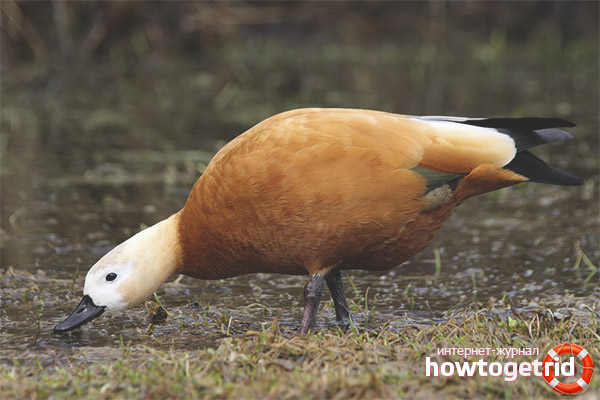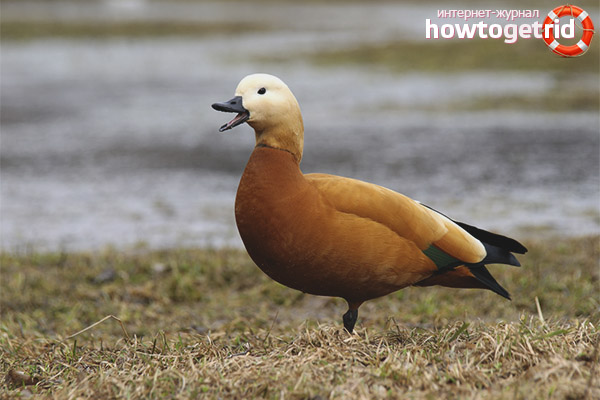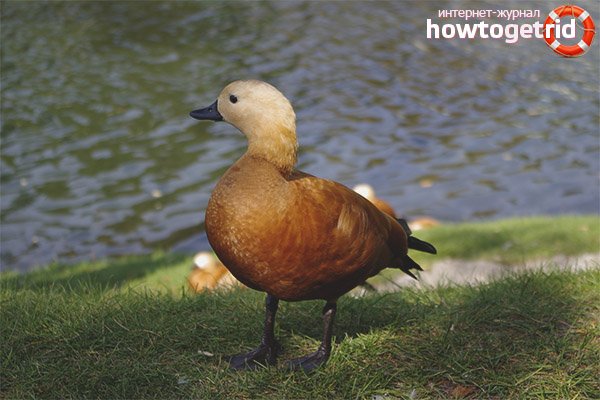The content of the article
Walking in some Moscow regions, you can notice a surprisingly beautiful bird with an unusual plumage of bright orange color. This bird, belonging to the family of ducks, is called a firebird (in other words - a red duck). Many peoples in different corners of the earth revered this small beautiful sacred bird. Previously, it was among the endangered species and was listed in the World Red Book. And only recently was hunting allowed.
Description and appearance
The peculiarity of this bird that distinguishes it from others is the plumage of bright shades, the body is orange with brown. At the beginning of the year, the bird is painted in darker shades, and by autumn the color fades, becoming paler and brighter. The neck and head are white with a copper tint. At the tail and the tail, the tide is green. The mandible with the mandible at the edges have rare, rather thin large teeth. White wings are decorated with black fly feathers, the same colors at the beak and long rather strong legs. When the bird is in flight, large whitish spots are visible on the lower part of the wings.
Proportions and sizes of duck
- Weight - from 1 to 1.5 kg.
- Length - from 60 to 68 cm.
- Wingspan - up to 145 cm.
During the mating season, a black ring forms around the neck of the male, disappearing with seasonal molting and feather changes, while the female has light feathers on the head from the side, which also disappear during the period of plumage change.
The duck is a great runner, an excellent swimmer, and a skilled diver. And she is able to dive even after receiving wounds. Thanks to its wide and large wings, it flies superbly. True, the air gives the impression of a heavy bird.
Features
- They never stray into flocks of large sizes, live in pairs or small groups, which include from two to four pairs.
- They can live in small spaces of water.
- During the mating season and courtship, it is not the male who picks up a pair for himself, like most birds, but the female.
- In any reservoir, this bird behaves quite aggressively, especially at the time of nesting, or if there is a brood nearby. He drives other birds away, clashes and squabbles with ducks and drakes of the same species.
Habitat
- China, the provinces located in the center, as well as in the southeast of the country.
- Central Asia and Central Asia, Mongolia and Tuva boast the largest accumulation of fires.
- In Turkey, in the territories of Iran, the Afghan Republic, and Iraq, many representatives of this species live.
- In the northwestern African regions of these birds, there are up to 2500 thousand pieces.
- About five hundred ducks live in hot Ethiopia.
- In Europe, this species inhabits the western regions of the Black Sea (in Bulgaria and a little in Romania) and lives in the north of the Aegean Sea.
- The duck ogar populates Russia from the south of the Kuban to the Far East (Amur Region). It is not only in the northern cold regions of the country.
- In Ukraine, the population is very small and is listed in the local Red Book.
The geography of habitat is very wide, however, due to human economic activities, the population is constantly declining. There are frequent cases of resettlement of wild birds in the city limits. An example is ducks living within the capital. This population appeared in the late 40s of the 20th century, when several birds flew from the Moscow Zoo. They bred, began to live in several Moscow regions, zoo workers feed them in lean crop years.
Nesting
The bird is monogamous, the marriage union lasts for many years. A drake or a duck creates a new pair only in the event of the death of a life partner.
Pairs are formed either during wintering, or upon the arrival of birds to their native places. They return from their wintering places early - in mid-March, when the water surface is still covered with ice - and immediately begin to look for a couple. It is not the male who is engaged in the choice, but the female. She attracts attention with loud screams, performing a kind of dance around her future half. The drake, silently, stands with its paw up and its neck extended, or walks around the future darling. Before pairing, they must make a pair flight.
Having mated, the couple begins to build a nest, at the bottom of which a litter is made of their own down. For nesting, they look for old abandoned burrows of any animals - gophers, hamsters, foxes. They can nest in tree hollows or in rock crevices. Not always a nest is located near a reservoir - it can be several kilometers away.
After about a month and a half, eggs of cream or white are laid in approximately 8 to 12 eggs. Sometimes it reaches 17 eggs, but such cases are rare. Eggs hatch from 4 weeks to a month - depending on weather conditions. The male bears guard over the entire period of hatching eggs and, seeing the danger, attacks everyone who dares to go too close to the nest. There are many cases when the drake - a fire attacked an enemy that is clearly superior in size and strength - the protective instinct is so strong.
Chicks
Hatching, drying out and recovering, the chicks immediately go to the nearest body of water and swim under the supervision of their mother. They return to their native nest only to spend the night. Both the female and the drake carry out childcare equally. After 55 days, the grown up kids stand on the wing, become independent, and they no longer need parental care. They begin to live their own lives, make couples, build nests.
Nutrition

The fire can find food both in the depths of reservoirs and on the dry surface of the earth. For the most part, prefers food of plant origin: various herbs, seeds, cereal shoots. But she also uses protein food with pleasure: on land - locusts, grasshoppers, grasshoppers, mollusks, crustaceans, small fish are extracted from the water, sometimes she manages to catch frogs. They also hunt in harvested fields, hatching cereal seeds from the ground, as well as on the roads along which grain was transported - an intelligent bird picks up and pecks up waking grains.
Personal breeding
It is easy to breed and maintain a bird on a personal farm - this is not a problem. It is mainly contained as a decorative look as a kind of decoration.
The fire is very trusting, getting used to a person does not last long - especially if the bird was caught and settled in a young household. The content is unpretentious, takes root well. It is only necessary to take into account its bellicose nature in the breeding era - at this time it shows aggression even to birds of its kind, so you should highlight a large area where there will be no strangers. For swimming and diving it is useful to create a special reservoir of artificial nature. In captivity, scorching begin in the seventh month of life.
Leaving in captivity
To care for this pet should be the same as for other representatives of ducks. The fire is very unpretentious, it only needs a shed for life. The only thing is necessarily with an insulated floor. To do this, it is covered with straw or sawdust. Of course, ducks need daily walks, as well as swimming. In winter, the shed and floor need to be warmed even more and put a drinking bowl, where there should always be water.
For feeding, ordinary duck food is suitable - bran, crops, waste from the master's table.Boiled vegetables rich in vitamins should be added to the diet only in winter.
Economic value
As a commercial bird, it matters little. Contained not only as a decoration, but also brings other benefits. Due to its egg production, it is able to lay more than a hundred eggs in a year. Due to the fact that the duck fire quickly gaining weight, it is used to obtain meat. Its quality largely depends on what the duck was fed. The meat is quite tender, low in fat, and suitable for dietary nutrition.
The thick duck feather is also widely used on the farm. Warm and weightless feathers go to the production of blankets and winter clothes - for example, down jackets.
Interesting Facts
With its appearance and proud bearing of the duck, the ogara outwardly resembles a small goose.
Also, the fire has a feature that distinguishes it from other ducks - the voice. He does not know how to quack in the usual sense of the word; a sharp, piercing voice is more like a donkey neigh. During the flight, the ducks shout something similar to "gang ...", and the scream goes into a trill. Females have a sharper and more piercing voice than males.
Ducks living in the middle zone of Russia, as a rule, remain in the places of residence for the winter period, without flying anywhere. They have good adaptability to the harsh winter climate. They prefer to winter in parks.
As a rule, people search for food in the dark, devote the daytime to rest, standing on one paw and digesting food.
A young bird can live in captivity for about 12 -13 years.
In autumn, the bird eats mostly plant foods and the meat becomes quite tasty and does not contain extraneous flavors. And since hunting is allowed, they hunt for a fire as well as for ducks of other species. Skradok is made near the reservoir, and from there the hunters guard and shoot the prey. The peculiarity of hunting ducks of this species is that you need to shoot immediately a couple, and not just one bird. Because, as soon as one of them dies, the other begins to circle over the place where the partner died, screaming very sadly and heartbreakingly. Not a very pleasant sight.
Video: Ogary (Tadorna ferruginea)













Submit